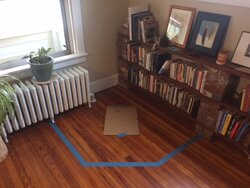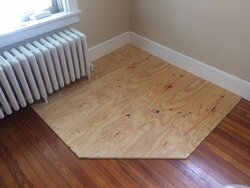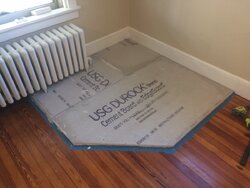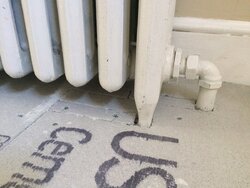Hello everyone. I have an opportunity to get a free hand-me-down Vermont Castings Aspen stove to install in the corner of the living room in the new house I just bought. I've been reading through posts on this forum for DIY hearth ideas and this community is an outstanding resource. I've never built a hearth pad before, or laid tile, so I figured that I'd document my experience here for anyone else looking to do the same. I also thought that posting my thoughts and progress would invite good recommendations from the knowledgeable forum members.
Here's a photo of the location where the stove is going to be installed (I don't have the stove yet - it's coming in a couple weeks). The cardboard cutout is the 16"x23" footprint and the painters tape is roughly where the pad will sit. You can see that it's going to be a little wonky with the radiator right there, but this is really the best spot given the orientation of the room. The bookshelf is just freestanding and is obviously going to come out.

Per the stove's manual (p. 13), the bottom shield provides the heat protection and the pad is there for spark and ember protection. There is only 3" of clearance under the radiator so I'd like to make the pad thin-ish. My design is slate tile on top of 1/2" hardieback on top of 1/2" plywood on top of the hardwood floor. I'll have to cut around two sets of radiator legs as well as the pipe that feeds the radiator. There isn't going to be any shield on the wall so I will set the rear corners 15" from the baseboard trim (manual says a minimum of 13"). The front of the pad will be 16.5" from the front of the stove footprint (manual says a minimum of 16").
One thing I'm unsure of is how to finish the face of the pad. My neighbor is a professional tiler so I'm going to end up borrowing his tools and he's got a wetsaw. I was thinking I might cut lengths of slate and run them around the perimeter on the vertical face. This would probably look better than trimming it with wood, especially when it is grouted.
Here's a photo of the location where the stove is going to be installed (I don't have the stove yet - it's coming in a couple weeks). The cardboard cutout is the 16"x23" footprint and the painters tape is roughly where the pad will sit. You can see that it's going to be a little wonky with the radiator right there, but this is really the best spot given the orientation of the room. The bookshelf is just freestanding and is obviously going to come out.

Per the stove's manual (p. 13), the bottom shield provides the heat protection and the pad is there for spark and ember protection. There is only 3" of clearance under the radiator so I'd like to make the pad thin-ish. My design is slate tile on top of 1/2" hardieback on top of 1/2" plywood on top of the hardwood floor. I'll have to cut around two sets of radiator legs as well as the pipe that feeds the radiator. There isn't going to be any shield on the wall so I will set the rear corners 15" from the baseboard trim (manual says a minimum of 13"). The front of the pad will be 16.5" from the front of the stove footprint (manual says a minimum of 16").
One thing I'm unsure of is how to finish the face of the pad. My neighbor is a professional tiler so I'm going to end up borrowing his tools and he's got a wetsaw. I was thinking I might cut lengths of slate and run them around the perimeter on the vertical face. This would probably look better than trimming it with wood, especially when it is grouted.




